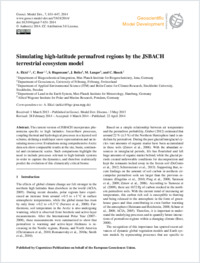Simulating high-latitude permafrost regions by the JSBACH terrestrial ecosystem model
- Ekici, A. Department of Biogeochemical Integration, Max Planck Institute for Biogeochemistry, Jena, Germany - Department of Geosciences, University of Fribourg, Switzerland
- Beer, C. Department of Biogeochemical Integration, Max Planck Institute for Biogeochemistry, Jena, Germany - Department of Applied Environmental Science (ITM) and Bolin Centre for Climate Research, Stockholm University, Sweden
- Hagemann, S. Department of Land in the Earth System, Max Planck Institute for Meteorology, Hamburg, Germany
- Boike, J. Alfred Wegener Institute for Polar and Marine Research, Potsdam, Germany
- Langer, M. Alfred Wegener Institute for Polar and Marine Research, Potsdam, Germany
- Hauck, Christian Department of Geosciences, University of Fribourg, Switzerland
-
22.04.2014
Published in:
- Geoscientific Model Development. - 2014, vol. 7, no. 2, p. 631–647
English
The current version of JSBACH incorporates phenomena specific to high latitudes: freeze/thaw processes, coupling thermal and hydrological processes in a layered soil scheme, defining a multilayer snow representation and an insulating moss cover. Evaluations using comprehensive Arctic data sets show comparable results at the site, basin, continental and circumarctic scales. Such comparisons highlight the need to include processes relevant to high-latitude systems in order to capture the dynamics, and therefore realistically predict the evolution of this climatically critical biome.
- Faculty
- Faculté des sciences et de médecine
- Department
- Département de Géosciences
- Language
-
- English
- Classification
- Meteorology, climatology
- License
- License undefined
- Identifiers
-
- RERO DOC 210038
- DOI 10.5194/gmd-7-631-2014
- Persistent URL
- https://folia.unifr.ch/unifr/documents/303554
Statistics
Document views: 100
File downloads:
- hau_shl.pdf: 143
